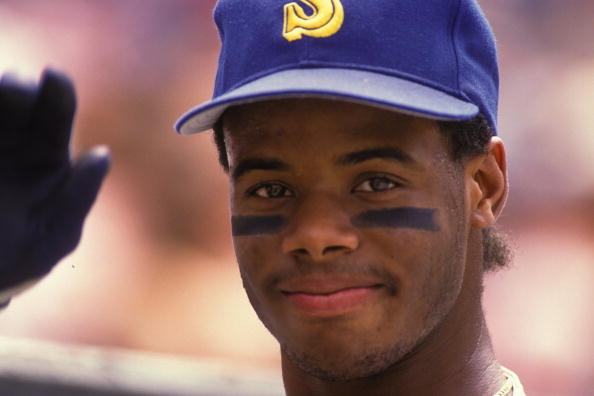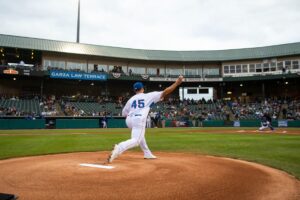How does this sound for the ultimate trade: Ken Griffey Jr. for Babe Ruth? Never happen right? Ken Griffey Jr. was born on November 21, 1969, and Babe Ruth died on August 16, 1948, so there’s that. Also, Ruth played in his last big league game on May 30, 1935, and Griffey played in his first on April 3, 1989. So either we have a weird Weekend at Bernie’s situation here or a Back to the Future time-travel leap. Either way, all signs point to it’s never going to happen. But it did happen. And here’s how.
Bad Trade: Ken Griffey Jr. For Babe Ruth
It was mid-July 1989. Two nine-year-old boys were sitting in a room, the ceiling fan slowly turning above, each had a box of baseball cards in front of them. They’d spent the better part of that morning playing home run derby at the park across the street. It had been a rout. No contest. Ben had laced tennis ball after tennis ball past the curving sidewalk that was the pseudo-home run fence. It wasn’t Kenny’s day. The ball found the backstop more than the barrel of the aluminum Easton bat. Following the derby, they’d had peanut butter and jelly sandwiches, Cheetos, and Minute Made fruit punch. Perfect fuel for trading cards.
Kenny had been eyeballing Ben’s ’89 Upper Deck Ken Griffey Jr. Of course, he had. No collector of baseball cards in 1989 could deny their desire to have at least one of those cards. The question was what would Kenny have to give to get it? An arm? Leg? Possibly a Babe Ruth card?
The Griffey
Before we move on you need to understand that the ’89 Upper Deck Ken Griffey Jr. was the card to HAVE back then. If you were there, if you had one, or if your friend did and you held it in your greedy little hands, you know, but if not, we’ll back up a bit.
Before 1989 Upper Deck came on the scene, baseball cards were more pliable, less glossy, didn’t come in a foil pack, and were hologram free. ’89 Upper Deck changed all that. Pre-’89 was the Dark Ages and when Upper Deck was released the Renaissance began. The cards cost more, nearly twice as much, a pack of ’89 Topps came in at $ 0.45 and a pack of Upper Deck ran $1.00. If a baseball card collector in 1989 wanted to treat themselves they went with Upper Deck.
But it wasn’t just the cards, it was the guy too, the Kid, it was the #1 card, which was Griffey. And the new card company, Upper Deck, had gambled making Griffey their #1. He was untested. He had never played above Double-A ball. They could have just gone with Gregg Jefferies. Jefferies was a lock. He’d already spent a little time in the bigs in ’87 and ’88. Jefferies was the safer bet, but Upper Deck didn’t play it safe and it paid off.
Upper Deck didn’t even have a photo of Griffey in a Seattle Mariners uniform so they photo “airbrushed” one using a graphics machine. The photo that you see on the card is Griffey wearing a San Bernardino Spirit uniform, not a Mariners. But after a coat or two of paint, abracadabra, you have Griffey in an M’s uniform. Pretty slick, right? And no one at the time was the wiser, at least not a nine-year-old kid.
The Ruth
The trick is that the Babe Ruth card looked genuine, just like the airbrushed Griffey photo, but it was not. Who knew, not Ben that’s for sure. Kenny? Well…
The card that was offered up in trade for the Griffey was technically a Babe Ruth baseball card. It coved the baseball card checklist: trading card relating to baseball on cardboard. Done. Ben was shocked. He asked Kenny if he could hold it. Kenny said, “you can have it for the Griffey.” Ben knew he could always get a Giffey again, but a Ruth? Maybe never.
The Ruth card was from arguably the most important baseball card set of the 1930s, the 1933 Goudey Big League Gum set. The Goudey Gum Company released the set and the packs of cards were one of the first to have a stick of gum inside. The set also paved the way for modern-day baseball cards with their thicker cardboard and larger card size. Included in the set were four Babe Ruth cards (#53, #144, #149, #181). The card that Kenny had offered up was card #53, which is also the rarest of all four of the Ruth cards in the set. And while nine-year-old Ben knew none of this, he did know that it was a Ruth card.
So, Ken Griffey Jr. For Babe Ruth?
“Yes,” said Ben, and the exchange happened. Kenny looked down at his newly acquired Griffey and Ben studied his Ruth.
The Goudey card was a beauty with its yellow background and red “Big League Chewing Gum” banner at the bottom. The illustration of Ruth shows the slugger in his follow-through after taking a swing. And in the upper right-hand corner is written “George Herman (Babe) Ruth”. It was too good to be true. The trade could not be topped and the emotional ride that they had just taken signaled an end to their day. Ben went home with his box of cards and his newly found treasure. Kenny eyed his ill-begotten gain.
Mother Knows Best
Ben was floating on a cloud when he got home. “Hey Mom, check it out,” he said. “Look what I traded for. A Babe Ruth card.”
Ben’s mom was by no means a baseball card aficionado. In fact, at the time, she wasn’t even too much of a baseball fan, preferring the gridiron to the diamond. But, she was no fool. “Let me see that,” she said, the skeptical tone of her voice uncontrollably oozing out. “What did you trade for this?”
“Just the Griffey rookie card. That’s it. This card is worth so much more.”
“Do you mean the Griffey card that you and your friends have been talking about all summer?”
“That’s the one.”
“There’s no way this is real, Ben. We’re going back to Kenny’s and you’re getting that card back.”
“But, mom.”
“No, buts, Ben.”
Kenny Comes Clean
“My grandma gave me the set for Christmas,” said Kenny, who looked a bit like a turtle hiding its head in its shell. “It’s a reprint, sorry, I just really wanted that card.”
Six years earlier, in 1983, the Galasso Company had issued a 50th anniversary 1933 Goudey reprint set that was identical to the original. All 240 cards were included, as well as the extremely rare Nap Lajoie. A beautiful set in its own right, but not the original.
The boys made the exchange. Ben had his Griffey back and Kenny had his Ruth.
“Sorry again,” said Kenny.
“Don’t worry about it. Baseball tomorrow?”
“I’m in, see you tomorrow.”
And that is how, in 1989, Ken Griffey Jr. was traded for Babe Ruth (and then traded back again).
Main Photo:
Players Mentioned:
Ken Griffey Jr., Babe Ruth, Gregg Jefferies, Nap Lajoie






